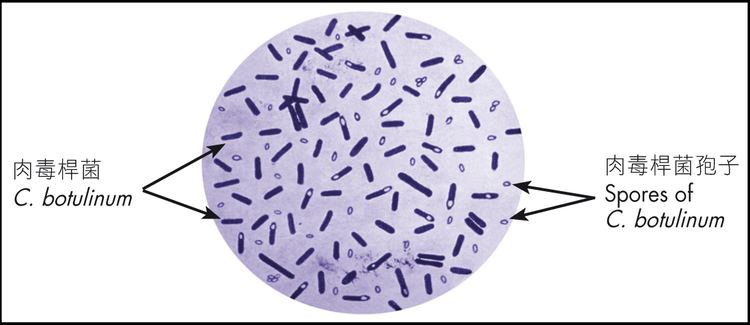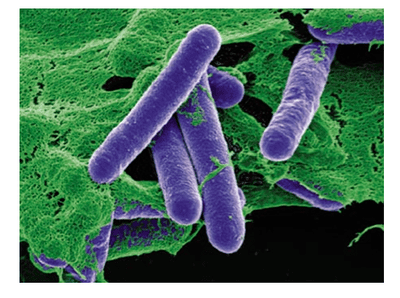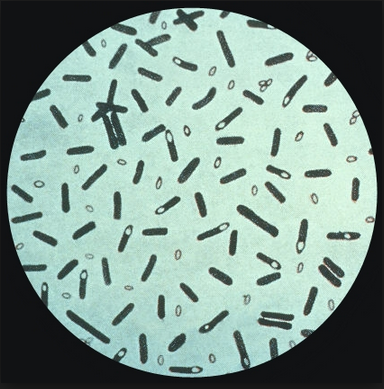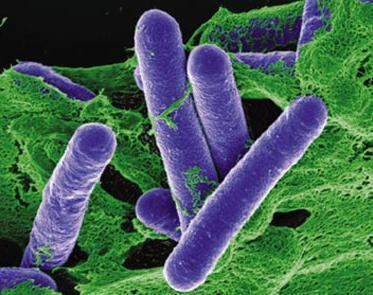Order Clostridiales Rank Species | Phylum Firmicutes Higher classification Clostridium | |
 | ||
Similar Bacteria, Human, Listeria, Bacillus, Vibrio | ||
Clostridium botulinum is a Gram-positive, rod-shaped, anaerobic, spore-forming, motile bacterium with the ability to produce the neurotoxin botulinum. The botulinum toxin can cause a severe flaccid paralytic disease in humans and other animals and is the most potent toxin known to mankind, natural or synthetic, with a lethal dose of 1.3–2.1 ng/kg in humans.
Contents
- Microbiology
- Groups
- Botulinum toxin
- Botulinum toxin types
- Laboratory isolation
- Taxonomy history
- Pathology
- C botulinum in different geographical locations
- North America
- Europe
- Australia
- Other
- Prevention Methods
- Growth Conditions
- Diagnostic methods
- References

C. botulinum is a diverse group of pathogenic bacteria initially grouped together by their ability to produce botulinum toxin and now known as four distinct groups, C. botulinum groups I-IV. C. botulinum groups I-IV, as well as some strains of Clostridium butyricum and Clostridium baratii, are the bacteria responsible for producing botulinum toxin.

C. botulinum is responsible for foodborne botulism (ingestion of preformed toxin), infant botulism (intestinal infection with toxin-forming C. botulinum), and wound botulism (infection of a wound with C. botulinum). C. botulinum produces heat-resistant endospores that are commonly found in soil and are able to survive under adverse conditions.

C. botulinum is commonly associated with bulging canned food; bulging, misshapen cans are due to an internal increase in pressure caused by gas produced by the bacteria.

Microbiology

C. botulinum is a Gram-positive, rod-shaped, spore-forming bacterium. It is an obligate anaerobe, meaning that oxygen is poisonous to the cells. However, C. botulinum tolerates traces of oxygen due to the enzyme superoxide dismutase, which is an important antioxidant defense in nearly all cells exposed to oxygen. C. botulinum is only able to produce the neurotoxin during sporulation, which can only happen in an anaerobic environment. Other bacterial species produce spores in an unfavorable growth environment to preserve the organism's viability and permit survival in a dormant state until the spores are exposed to favorable conditions.

C. botulinum is divided into four distinct phenotypic groups (I-IV) and is also classified into seven serotypes (A-G) based on the antigenicity of the botulinum toxin produced.
Groups
The classification into groups is based on the ability of the organism to digest complex proteins. Studies at the DNA and rRNA level support the subdivision of the species into groups I-IV. Most outbreaks of human botulism are caused by group I (proteolytic) or II (non-proteolytic) C. botulinum. Group III organisms mainly cause diseases in animals. Group IV C. botulinum has not been shown to cause human or animal disease.
Botulinum toxin
Neurotoxin production is the unifying feature of the species. Seven types of toxins have been identified that are allocated a letter (A-G). All toxins are rapidly destroyed at 100 °C, but they are resistant to degradation by enzymes found in the gastrointestinal tract. This allows for ingested toxin to be absorbed from the intestines into the bloodstream.
Most strains produce one type of neurotoxin, but strains producing multiple toxins have been described. C. botulinum producing B and F toxin types have been isolated from human botulism cases in New Mexico and California. The toxin type has been designated Bf as the type B toxin was found in excess to the type F. Similarly, strains producing Ab and Af toxins have been reported. Evidence indicates the neurotoxin genes have been the subject of horizontal gene transfer, possibly from a viral source. This theory is supported by the presence of integration sites flanking the toxin in some strains of C. botulinum. However, these integrations sites are degraded, indicating that the C. botulinum acquired the toxin genes quite far in the evolutionary past.
Botulinum toxin types
Only botulinum toxin types A, B, E, and F cause disease in humans. Types A, B, and E are associated with foodborne illness, with type E specifically associated with fish products. Type C produces limberneck in birds and type D causes botulism in other mammals. No disease is associated with type G. The "gold standard" for determining toxin type is a mouse bioassay, but the genes for types A, B, E, and F can now be readily differentiated using quantitative PCR.
A few strains from organisms genetically identified as other Clostridium species have caused human botulism: C. butyricum has produced type E toxin and C. baratii had produced type F toxin. The ability of C. botulinum to naturally transfer neurotoxin genes to other clostridia is concerning, especially in the food industry, where preservation systems are designed to destroy or inhibit only C. botulinum but not other Clostridium species.
Laboratory isolation
In the laboratory, C. botulinum is usually isolated in tryptose sulfite cycloserine (TSC) growth medium in an anaerobic environment with less than 2% oxygen. This can be achieved by several commercial kits that use a chemical reaction to replace O2 with CO2. C. botulinum is a lipase-positive microorganism that grows between pH of 4.8 and 7.0 and cannot use lactose as a primary carbon source, characteristics important for biochemical identification.
Taxonomy history
C. botulinum was first recognized and isolated in 1895 by Emile van Ermengem from home-cured ham implicated in a botulism outbreak. The isolate was originally named Bacillus botulinus, after the Latin word for sausage, botulus. ("Sausage poisoning" was a common problem in 18th- and 19th-century Germany, and was most likely caused by botulism) However, isolates from subsequent outbreaks were always found to be anaerobic spore formers, so Ida A. Bengtson proposed that the organism be placed into the genus Clostridium, as the Bacillus genus was restricted to aerobic spore-forming rods.
Since 1959, all species producing the botulinum neurotoxins (types A-G) have been designated C. botulinum. Substantial phenotypic and genotypic evidence exists to demonstrate heterogeneity within the species. This has led to the reclassification of C. botulinum type G strains as a new species, C. argentinense.
Group I C. botulinum strains that do not produce a botulin toxin are referred to as C. sporogenes.
The complete genome of C. botulinum has been sequenced at Wellcome Trust Sanger Institute in 2007.
Pathology
Botulism poisoning can occur due to preserved or home-canned, low-acid food that was not processed using correct preservation times and/or pressure.
Foodborne botulism "Signs and symptoms of foodborne botulism typically begin between 18 and 36 hours after the toxin gets into your body, but can range from a few hours to several days, depending on the amount of toxin ingested."
Wound botulism Most people who develop wound botulism inject drugs several times a day, so it's difficult to determine how long it takes for signs and symptoms to develop after the toxin enters the body. Most common in people who inject black tar heroin, wound botulism signs and symptoms include:
Infant botulism If infant botulism is related to food, such as honey, problems generally begin within 18 to 36 hours after the toxin enters the baby's body. Signs and symptoms include:
Beneficial effects of botulinum toxin: Purified botulinum toxin is diluted by a physician for treatment:
Adult intestinal toxemia A very rare form of botulism that occurs by the same route as infant botulism but is among adults. Occurs rarely and sporadically.
C. botulinum in different geographical locations
A number of quantitative surveys for C. botulinum spores in the environment have suggested a prevalence of specific toxin types in given geographic areas, which remain unexplained.
North America
Type A C. botulinum predominates the soil samples from the western regions, while type B is the major type found in eastern areas. The type-B organisms were of the proteolytic type I. Sediments from the Great Lakes region were surveyed after outbreaks of botulism among commercially reared fish, and only type E spores were detected. In a survey, type-A strains were isolated from soils that were neutral to alkaline (average pH 7.5), while type-B strains were isolated from slightly acidic soils (average pH 6.25).
Europe
C. botulinum type E is prevalent in aquatic sediments in Norway and Sweden, Denmark, the Netherlands, the Baltic coast of Poland, and Russia. The type-E C. botulinum was suggested to be a true aquatic organism, which was indicated by the correlation between the level of type-E contamination and flooding of the land with seawater. As the land dried, the level of type E decreased and type B became dominant.
In soil and sediment from the United Kingdom, C. botulinum type B predominates. In general, the incidence is usually lower in soil than in sediment. In Italy, a survey conducted in the vicinity of Rome found a low level of contamination; all strains were proteolytic C. botulinum types A or B.
Australia
C. botulinum type A was found to be present in soil samples from mountain areas of Victoria. Type-B organisms were detected in marine mud from Tasmania. Type-A C. botulinum has been found in Sydney suburbs and types A and B were isolated from urban areas. In a well-defined area of the Darling-Downs region of Queensland, a study showed the prevalence and persistence of C. botulinum type B after many cases of botulism in horses.
Other
A "mouse protection" or "mouse bioassay" test determines the type of C. botulinum toxin present using monoclonal antibodies. An enzyme-linked immunosorbent assay (ELISA) with digoxigenin-labeled antibodies can also be used to detect the toxin, and quantitative PCR can detect the toxin genes in the organism.
C. botulinum is also used to prepare the medicaments Botox, Dysport, Xeomin, and Neurobloc used to selectively paralyze muscles to temporarily relieve muscle function. It has other "off-label" medical purposes, such as treating severe facial pain, such as that caused by trigeminal neuralgia.
Botulinum toxin produced by C. botulinum is often believed to be a potential bioweapon as it is so potent that it takes about 75 nanograms to kill a person (LD50 of 1 ng/kg, assuming an average person weighs ~75 kg); 1 kilogram of it would be enough to kill the entire human population. For comparative purposes, a quarter of a typical grain of sand's weight (350 ng) of botulinum toxin would constitute a lethal dose for humans.
C. botulinum is a soil bacterium. The spores can survive in most environments and are very hard to kill. They can survive the temperature of boiling water at sea level, thus many foods are canned with a pressurized boil that achieves even higher temperatures, sufficient to kill the spores.
Growth of the bacterium can be prevented by high acidity, high ratio of dissolved sugar, high levels of oxygen, very low levels of moisture, or storage at temperatures below 3 °C (38 °F) for type A. For example, in a low-acid, canned vegetable such as green beans that are not heated enough to kill the spores (i.e., a pressurized environment) may provide an oxygen-free medium for the spores to grow and produce the toxin. However, pickles are sufficiently acidic to prevent growth; even if the spores are present, they pose no danger to the consumer. Honey, corn syrup, and other sweeteners may contain spores, but the spores cannot grow in a highly concentrated sugar solution; however, when a sweetener is diluted in the low-oxygen, low-acid digestive system of an infant, the spores can grow and produce toxin. As soon as infants begin eating solid food, the digestive juices become too acidic for the bacterium to grow.
Prevention Methods
The control of food-borne botulism caused by C. botulinum is based almost entirely on thermal destruction (heating) of the spores or inhibiting spore germination into bacteria and allowing cells to grow and produce toxins in foods. The FDA and CDC give the following guidelines for preventing foodborne botulism:
Growth Conditions
Conditions conducive of growth are dependent on various environmental factors. Growth of C. botulinum is a risk in low acid foods as defined by having a pH greater than 4.6 although growth is significantly retarded for pH below 4.9. There have been some cases and specific conditions reported to sustain growth with pH below 4.6.
C. botulinum is an obligate anaerobe that is widely distributed in nature and is assumed to be present on all food surfaces. Its optimum growth temperature is within the mesophilic range. In spore form, it is the most heat resistant pathogen that can survive in low acid foods and grow to produce toxin. The toxin attacks the nervous system and will kill an adult at concentrations of 10−6. This toxin is detoxified by holding food at 100 °C for 10 minutes.
Diagnostic methods
In the U.S Physicians may consider the diagnosis if the patient's history and physical examination suggest botulism. However, these clues are usually not enough to allow a diagnosis of botulism. Other diseases such as Guillain-Barré syndrome, stroke, and myasthenia gravis can appear similar to botulism, and special tests may be needed to exclude these other conditions. These tests may include a brain scan, spinal fluid examination, nerve conduction test (electromyography, or EMG), and a tensilon test for myasthenia gravis. Tests for botulinum toxin and for bacteria that cause botulism can be performed at some state health department laboratories and at CDC.
